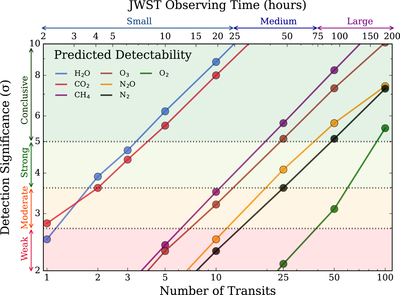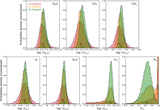Image Details

Caption: Figure 3.
Predicted detection significances of atmospheric molecular species for an Earth-like planet orbiting WD 1856+534. The predictions are given as a function of the number of transits (2.2 minute duration) and corresponding JWST observing time (including time constrained observation charges and overheads; see Section 3.1). The detection significances are sorted into “weak,” “moderate,” “strong,” and “conclusive” detections (shaded regions), according to an adaptation of the Jeffreys scale for Bayesian model comparisons (e.g., Trotta 2017). The boundaries (dotted lines) occur at 2.7σ, 3.6σ, and 5.0σ, respectively. Within a 10-transit small program (∼20 hr), H2O and CO2 can be conclusively detected, with CH4 and O3 detected to >3σ. A 25-transit medium program (∼50 hr) can conclusively detect CH4 and O3, while additionally detecting N2O to >4σ. A further increase to a 100-transit large program (∼200 hr) yields conclusive detections of N2 and O2.
Copyright and Terms & Conditions
© 2020. The American Astronomical Society. All rights reserved.






